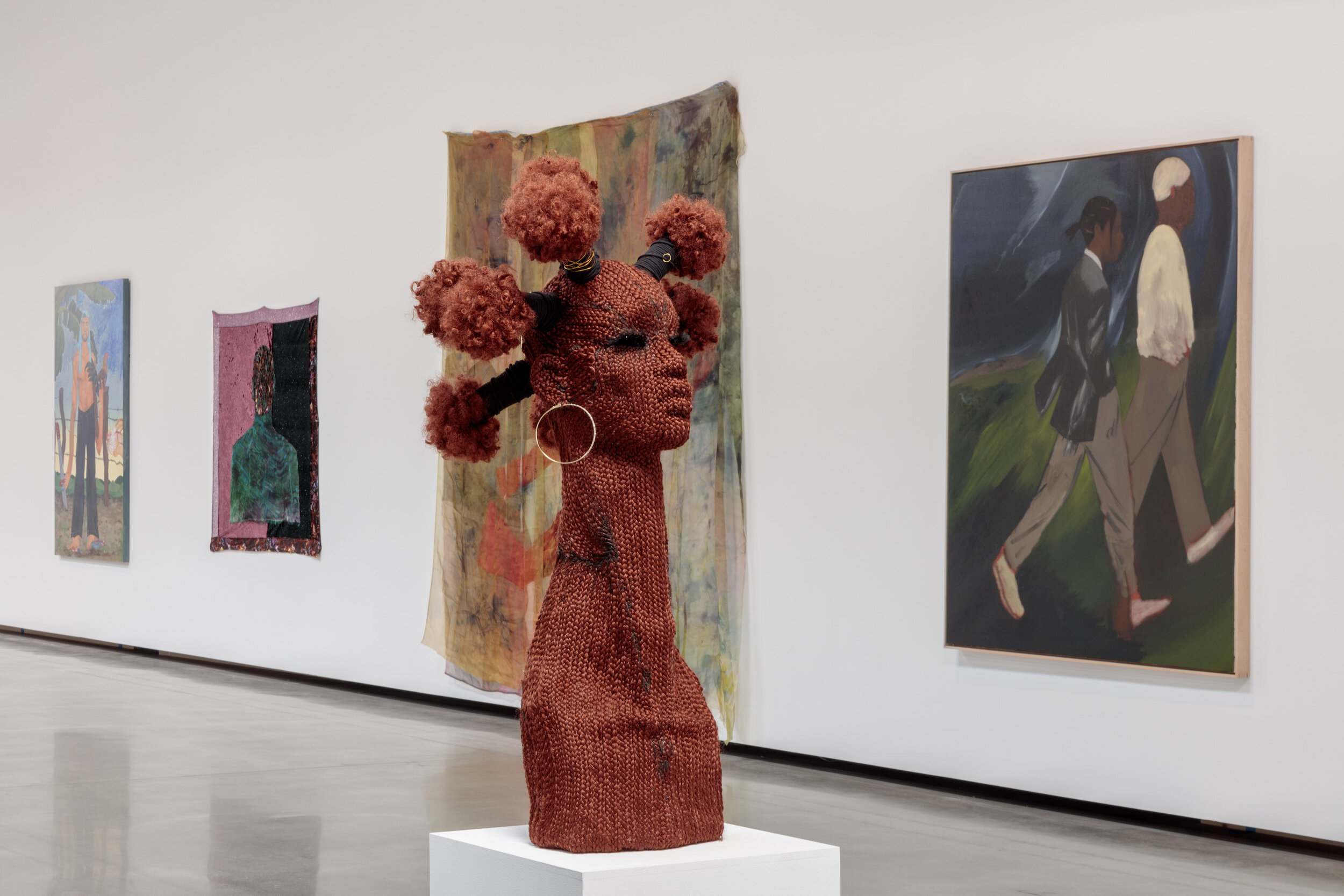Review: Shattered Glass at Jeffrey Deitch Gallery
Installation view of Shattered Glass, curated by Melahn Frierson and AJ Girard, Jeffrey Deitch, Los Angeles, 2021. Photo by Joshua White (@joshuawhitephotography / @white1977)
Melahn Frierson and AJ Girard’s curation for Shattered Glass at Jeffrey Deitch is a spectacular celebration of intellectual prowess, culture, and digs deep into the artists’ black and brown communities. Located on a quiet street amidst the hustle-and-bustle of a rapidly gentrifying Hollywood, the gallery’s open space features a collection of powerful works that authentically portray people of color. Magnificent in shape, scale and color, Shattered Glass includes 40 artists who “demand to take up space” while subjugating the audience’s notion of race, identity and materiality.
Beginning in the left portion of the gallery, I arrived at the mixed-media piece titled, Sondela Forever by artist Simphiwe Ndzube. Viewing Ndzube’s work I was drawn to the exaggerated smile on paper pasted on the canvas. The piece brought to mind Betye Saar’s work in assemblage and eschews a broad spectrum of unique materials including found objects and synthetic fabrics.
Installation view of Shattered Glass, curated by Melahn Frierson and AJ Girard, Jeffrey Deitch, Los Angeles, 2021 Photo by Joshua White (@joshuawhitephotography / @white1977)
Working myself around the room, La Lavada by Gabriela Ruiz literally pops out at you in a dynamic collage of screens, cameras and painted surfaces. The audience themselves are subjugated to the continuously recording surveillance cameras. This work serves as a reminder of the constant surveillance experienced in twenty first century society and the politics behind who controls the camera.
Kezia Harrell. Bliss: Americana Hot Mamma, 2021. Oil on birch panel with stretched canvas. 72 x 120 inches. Shattered Glass, curated by Melahn Frierson and AJ Girard, Jeffrey Deitch, Los Angeles, 2021 Photo by Joshua White (@joshuawhitephotography / @white1977)
In the following space, Kezia Harrell’s fantastical self-portrait, Bliss: Americana Hot Mamma, is an exhibition favorite. Harrell’s fairytale-like work shows the artist lying nude in a magical field with a cherub-like character dressed in a fluffy purple onesie. The portrait issues a modern interpretation of Ingres’ La Grande Odalisque and Manet’s Olympia. In this case, introducing bodies of color and the artist interpreting her own body; therefore owning her own power.
Poised and majestic, Standing in the Roaring 20’s by Mario Moore, gazes directly at the viewer and creates a realistic, humanistic sense of depth. The man in the portrait takes space with his eyes, embodying the environment; acknowledging he is in control. In comparison, Alfonso Gonzalez Jr.’s Sueños shows a solitary figure on horseback lost in his phone. The gigantism of the painting in itself creates a theatrical scene for the viewer to be fully encompassed within. Both works nod toward surrealism, the fantastical and a personal view into a dreamscape.
Raelis Vasquez. La Mesa Nuestra, 2021. Oil, acrylic and oil pastels on canvas, 60 x 84 inches. Shattered Glass, curated by Melahn Frierson and AJ Girard, Jeffrey Deitch, Los Angeles, 2021 Photo by Joshua White (@joshuawhitephotography / @white1977)
Brilliantly painted, La Mesa Nuestra by Raelis Vasquez reflects on a familial gathering in a pseudo-photographic depiction. Colorful tropical vegetation playfully frames the table. A child is asleep on the far end; each character’s personality is carefully regarded through body language and eye contact. Vasquez shows technical prowess as well as the ability to add a multi-layered contextual voice that digs deep into cultural heritage and importance of physical representation.
Tension by Jaime Muñoz is an inverted diptych focusing on contextual themes of religion, the relationship between art and institutional religious beliefs, and how these belief systems have been integrated into post-colonial communities. The works invert themselves in digital-like gridded spaces that reference electronic screens. The Pieta by Michelangelo is featured on both compositions reflecting the history of art in the Catholic Church and the permeation of forced religious affinity in the Americas. Bright reds and blues make for a dynamic set of works, Muñoz’s hand is hardly evident within the piece, given the exact precision in line and stroke.
rafa esparza. al Tempo, 2021. Acrylic on adobe 72 x 113.5 x 2 inches (diptych), 72 x 56.75 x 2 inches (each panel). Shattered Glass, curated by Melahn Frierson and AJ Girard, Jeffrey Deitch, Los Angeles, 2021 Photo by Joshua White (@joshuawhitephotography / @white1977)
Also a diptych, al Tempo by rafa esparza evokes the dreams and realities of Latino gay men in an intimate bar scene. Esparza’s work is painted on a crumbling surface with edges missing, reminiscent of the artist’s previous work with mud bricks. Various men in traditional dress with cowboy hats hold hands, while one character directly addresses the audience with his gaze.
Fulton Leroy Washington, (aka Mr. Wash) Targeted - Insurrection, 2021. Oil on canvas60 x 48 x 1.5 inches. Shattered Glass, curated by Melahn Frierson and AJ Girard, Jeffrey Deitch, Los Angeles, 2021 Photo by Joshua White (@joshuawhitephotography / @white1977)
Within the larger context of Shattered Glass is the notion of history painting. Targeted - Insurrection by Fulton Leroy Washington (aka Mr. Wash) directly confronts our recent past, in specific the insurrection of the U.S. Capitol Building on January 6, 2021. A distressed child is portrayed with a bubble showing the insurrection scenes of the US Capitol Building and Trump flags amid the chaotic mob. Bullet holes cover a metallic surface behind the child, enclosing the scene and bringing to kind the visceral violence perpetuated on communities of color.
While this is a brief overview, the 40 artists that make up Shattered Glass are brilliantly interwoven within the larger context of “taking up space.” With a plethora of extraordinary works, Shattered Glass is masterfully executed. The show’s effectiveness lies in its genuinity, showcasing artists and their histories, stories, families and truth.
The exhibition at Jeffrey Deitch Gallery in Los Angeles closes on May 22nd.





